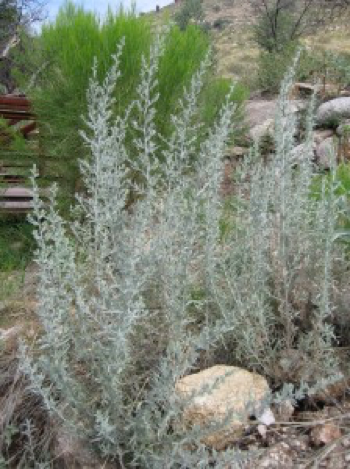Aretmisia ludoviciana – Estafiate
Other names: Western Mugwort, Western Wormwood, Louisiana Sagewort, Prairie Sagewort, Mountain Sage, Simonillo, Itzauhyatl (Nahuatl)
Origin: Native throughout the entire western US
Energetics: Warm & Dry. Bitter, Pungent, slightly Astringent. Vital stimulant, Tonic Relaxant
Properties: Digestive, Carminative, Diaphoretic, Aromatic Bitter, Anti-inflammatory, Analgesic, Decongestant, Sedative, Nervine, Hepatic, Cholagogue, Choleretic, Diuretic, Expectorant, Emmenagogue, Anodyne, Anthelmintic, Antioxidant, Antispasmodic, Anti-fungal, Hemostatic, Styptic
Organ Affinities: Liver, gall bladder, gut, nervous system, female reproductive, lungs, muscle tissue, tendons/ligaments, endocrine, brain, skin, blood
Uses: Internally: Indigestion, gas, bloating, poor appetite, acid reflux, GERD, mild constipation, gastritis, diarrhea, IBS symptoms, weakened digestion, gastroenteritis, pinworms, cold, flu, chest congestion, fever, traumatic injuries, amenorrhea, edema, nervous exhaustion, muscle pain. Externally: Broken bones, bruises, sprains, strains, nosebleeds, insect bites, stings (bee, scorpion), poison ivy rash, rheumatism, moxibustion Other uses from ethnobotanical sources include: Foot deodorant (placed in shoes), poultice of leaves applied to blisters and burst boils, chew leaves for respiratory disorders (children), tea of leaves for chest or throat constriction, sinus congestion in horses (tea), snuff for headaches, sinus problems or nosebleeds, leaves chewed and placed on insect, scorpion (Peter Bigfoot) or spider bites, salve for sores, infusion as wash for eczema, itching skin, sore eyes, infusion for head colds, bruises, itching, high fevers, for the lungs, to cut phlegm, diarrhea, regulator of menstrual disorders, sore throats, tonsillitis, mild cathartic, disinfectant (after funerals), indigestion, decoctions used for arthritis, eyewash, a wash or tea for colds, influenza, a soak for aching feet, severe infections, venereal diseases, rashes or skin eruptions, plant used extensively in ceremonies to drive away bad spirits, evil influences and ominous dreams, poultice of chewed leaves applied to sprains, swellings and assist in healing broken bones, seeds used as food, used extensively in the sweat lodge ceremonies, steeped leaves used as a compress for headaches, fevers in babies, rheumatism, decoction of root taken as a tonic after childbirth (Paiute), leaves placed in nostrils for a headache or cold, compound decoction of whole plant or plant tops taken for cough (Shoshoni). In University of Kansas’ Prairie Ethnobotany Database, A. ludoviciana had the highest number of uses catalogued over all prairie plants.
The particular species at hand, A. ludoviciana, is named for the previous Louisiana Territory as it is found throughout this area. It was named by Thomas Nuttall during his well-known botanical exploration there in the early 19th century. There are currently 5 recognized subspecies, and 2-3 can be found in southern Arizona. It is a tetraploid indicating it has evolved more recently than other Artemisia spp. in the west. It is a rhizomatous perennial. It puts out terminal racemes of yellow disc flowers near each summer solstice in the southwest. It is quite difficult to describe an archetypal Artemisia ludoviciana as there are varieties and differences in growth habit that can make one group of plants appear completely different from those growing 3000’ below the previous. In our desert canyons it can reach a height of over 7’. In Oregon it may only reach 1.5’ and grow in a thick bunch, 5’ x 8’, or climb to 12’ in subspecies estesii. Even the leaf color can vary considerably, but is normally tomentose and gray in appearance. Most smell fragrant, especially during the summer time, but in certain climes the leaves can be particularly sweet. No doubt, all these factors can influence the medicine you have. Each spring, with adequate moisture, it sends up various sprouts in a radius from the previous year’s growth.
Artemisia ludoviciana grows over the whole western US over the Mississippi into Wisconsin and Louisiana. There are 200-400 species of Artemisia worldwide.
Moon Goddess
Its name “Artemisia” comes from the Greek goddess of the moon, Artemis. There is a silky, luminescent presence to this plant persisting through the seasons. It covers so much ground here in the Southwest in a variety of habitats. It grows on shady hillsides shadowed throughout the winter months. It grows in cliff-side crags open to the sun. It towers amongst boulders in seasonal desert washes. It carpets the fertilized ground beneath oaks and junipers at mid-elevations. Its changing form is reminiscent of the moon to be sure. Just go to a different locale, it is sure to appear in a different, unique form. It smells particularly sweet in summer (where the pungency resides), and the bitterness can fade in winter time. Its taste may even give rise to thoughts of a newly discovered species before realizing that these helpers of Artemis have a great and varied way of being in the world. This adaptability is a mark of their function in helping to heal the human body.
Fluidity in Movement
Estafiate as a plant shows a sense of ease, softness, fluidity even. To do this amidst the harsh, wide ranging conditions of the desert is amazing in and of itself. Its touch is soft even throughout the fall and winter. The dried leaves which remain attached to the base of the stalk arising from joined, spreading rhizomes even remain soft and pliable in their desiccated state. These are the leaves often used for moxibustion. I gather them from the live plant once they have dried upon the stem. These moxa rolls, once lit, will infuse their warmth through the meridians enlivening blood flow, carrying chi throughout the body and opening places where cold and stagnation settle. Thus the body feels more integrated, invigorated, and at ease. The Chinese would say this is the Liver at work. No, not necessarily our liver organ, but that which it governs, or commands, as it were, in the human body. Known as the “General” the Liver houses our ability to see clearly the vast playing field of our lives, and the capacity to make decisions without doubt and deliberation providing a fluid and seamless interplay with our environment. It is our “get up and go” energy. In health, it promotes the movement of the blood, therefore the movement of chi, throughout the body. All bodily functions become nourished, and the mind is at ease. Estafiate has an affinity for releasing stagnation from the liver and smoothing out the flow of chi from the Liver. I have seen this firsthand when an acute gall bladder attack is averted upon chewing a few leaves, or applying the oil infusion topically. The tension in the body is released, the space is broadened, and the built up energy begins to dissipate. Our Grape Root species (Mahonia spp.) do something similar, but there it is more of a cooling and draining effect without the smoothing action (Peony helps out a lot with that). Opening up the flow of chi helps nourish the tendons and invigorates the body in a relaxed way. Some are more sensitive to it than others, but it will always be there.
I’ve noticed that the windy seasons produce a set of symptoms in people which affect the Liver and Gall Bladder, generally. It can be the actual organs, or the energetics associated with each; frustration, anger, impatience, inability to make a decision, ‘can’t think straight.‘ Various Estafiate applications (tea, fresh herb, fomentation, tincture, poultice, foot bath, oil, salve) work well to quell these excitations. Use at the area of tension such as the rib cage, outer band of the legs, below the right breast onto the abdomen, below the right scapula, temples, or posterior sides of the neck. A short, warm bath with the tea added helps to sooth these energies. Some of us become used to “dealing with” this and not addressing it as it arises. Even if the immediate inconvenience/harm/injury is not severe, the accumulation is what fosters deeper illness and imbalances.
Host of Actions
I consider Estafiate one of our local “polycrests.” It is a commonly used herb with multiple actions on the body. Upon inspection, it can become difficult to find a situation where Estafiate may not be of help. Certainly, its dryness can exacerbate many conditions in our dry environment over time, but I manage to use it mostly in formulation allowing for an appropriate balance of energies. For some, its effect is felt immediately at the sinuses. It has an opening, clearing effect which can improve respiration immediately. I combine it in my Hay Fever Formula for this reason, in addition to its antioxidant and recuperative effects on the liver. New research into its anti-fungal effects make it useful in chronic sinus infections, as well. If you ask any Mexican(-American) over age 45 in this region who grew up with herbs they will tell you that their tía, or abuela used to give them Estafiate tea when they had a stomachache. “Oh, it was pretty strong, but it worked!” they would say. It’s hard to come up with a more all-around beneficial digestive remedy. If there’s constipation from a lack of bile invested in the process, Estafiate can help. If a case of food poisoning causes a debilitating bout of diarrhea, Estafiate can help (Yarrow, a close relative, does well here, too). If acid reflux keeps you up at night, Estafiate (along with some friends like Malva and Chamomile) can help again. It helps reduce inflammation in the gut and protects the mucosa upon irritation. It also works as an analgesic and is a fantastic aromatic bitter. Upon transitioning to a diet richer in animal foods, Estafiate helps improve deficient digestion and slow transit. It will help speed up digestion when it’s become too slow from unusually heavy foods or lymphatic stagnation. Even a ‘nervous stomach’ can be settled by 5-10 drops of the tincture in warm water or a half cup of the tea combined with Chamomile. Estafiate helps strengthen us from our foundational core: digestion. There’s a variety of micronutrients present in the plant which I presume come through in the tea (Vitamins A, B, & C, potassium, calcium, and iron). Reducing gut inflammation and astringing bogginess in the tissues allows for enhanced nutrient absorption. I like to include Estafiate in my soup blends, especially in the spring and fall (seasons in which the irritation from wind is most likely here) for its medicinal and nutritive effects. Taking it as a hot tea can be diaphoretic, carminative as well as emmenagogue for some women (I would look to find nervous system tension and liver tonicity; gripping things tightly, clenched mouth, tension in the torso). The tincture in hot water should work similarly. It may also be of use in improving estrogen clearance from the liver, similar to St John’s Wort. Chronic menstrual symptoms can be coming from a stagnancy in the liver, or deficient liver function. Look for cold hands and feet.
A nice formula here can be:
Estafiate 2 parts
St John’s Wort 2 parts
California Peony 2 parts
Bitter Orange Peel 1 part
Ginger 1 part
*taken as a tincture
I like to say that Estafiate “goes straight to the liver.” I haven’t found a liver condition yet where this plant wasn’t useful, from the acute one time dosage to daily usage over time for chronic issues and all methods in between. Another favorite application of mine is to use it in tea before bed for restless sleep. Here I often combine it with Chamomile and Milky Oats (see my Gut Healing Tea & Sonoran Sleep Tea formulas). I love its combination of properties here: aromatic bitter, relaxant nervine sedative, purging Liver stagnation, cooling the liver, and relaxing and smoothing Liver chi, and nutritive to the nervous system. What more can you ask for in an herb to help someone with nervous system depletion/anxiety/insomnia/signs of Liver deficiency? I like adding the Milky Oats (tea or tincture) to help nourish and strengthen the nervous system and adrenals. As far as the Milky Oats, I’ve needed to get 3-4 squirts of the tincture, 2x/day to see much benefit in individuals who are severely depleted and burned out. Another indication for Estafiate tea in the evening would be chronic viral infections causing excessive oxidative stress on the liver, waking up regularly between the hours of 1-3a, roughly, and prone to impatience, anger, frustration. Having all three of those is a perfect fit.
Powerful Pairings
Estafiate/Wild Ginger *warming to deficient digestion
Estafiate/Peony *PMS with cramping, anxiety, muscular tension
Estafiate/Chaparro Amargosa *giardia, intestinal parasites, gastritis, gastric ulcer
Estafiate/Prickly Pear flowers *adds moistening effect, antioxidant, prostate pain
Estafiate/Azahares *Nervine sedative blend, purging liver heat and calming the heart
Collecting & Preparation
I prefer to collect the herb before going into flower. This is generally around the summer solstice in our area, but oddly I did not find it flowering until late September last year. I cut the stem from below the last green leaves and either bundle to hang or leave loosely in paper bags to dry (You can also bundle to make smudge sticks at this point). Once dry you can begin stripping the leaves from the stem. The stem still has medicine, but I chop it and store it separately favoring it for decoctions for foot soaks, baths, and fomentations for all varieties of injuries for humans and animals alike. I use the fresh plant for tincture (1:2, 95% alcohol) and for oil infusion. This is one of very few plants I find works best as a fresh oil infusion. I’ve done it both ways, fresh and dry, and fresh is easier, more efficient in its yield, and a better representation of the plant. This can then be used to make salve, if desired. I believe an acetum (apple cider vinegar preparation) would also be useful topically for sprains, strained muscles, and bruises (similar to Lobelia, perhaps). Dosage on the tea usually need be no more than half a cup. Whenever I use it alone, only occasionally, this is the dosage I use. If attempting to treat a malarial fever without any other resources at hand, I may choose to use more of the hot tea, with frequent dosing. The tincture dosage is going to depend upon what your application is. In formulation, it can be 5-10 drops a day. Taken as a specific for indigestion, poor fat absorption, gall bladder pain, muscle tension, chronic infection, shingles pain, etc. I may suggest up to 45 drops in warm water, 3-8 times a day, depending. Yes, it all depends.
Estafiate can be used in the following ways: Decoction, Infusion, Tincture (Fresh or Dry), Acetum, Oxymel, Oil, Salve, Wash, Poultice, Fomentation, Steam Inhalation, Douche, Pessary, Chew, Snuff, Smudge.
References
Brounstein, Howie. Estes Artemesia: A Rare Mugwort from the Pacific Northwest.
Kahee & Gutierrez. Antibacterial Properties of Artemisia, McCutcheon, A.R. Antifungal screening of medicinal plants of British Columbian native peoples. Journal of Ethnopharmacology, Volume 44, Issue 3, December 1994, Pages 157–169.
Moerman, Daniel. 1998. Ethnobotany of North America.
Moore, Michael. 2003. Medicinal Plants of the Mountain West.
Rose, Kiva. January, 2007. The Medicine Woman’s Roots (Blog).
Santos, Garcia, et. al. Extracts of Acacia farnesiana and Artemisia ludoviciana inhibit growth, enterotoxin production and adhesion of Vibrio cholerae. WORLD JOURNAL OF MICROBIOLOGY AND BIOTECHNOLOGY, Volume 22, Number 7 (2006).
http://nativeplants.ku.edu/research/ethnobotany-database-2


